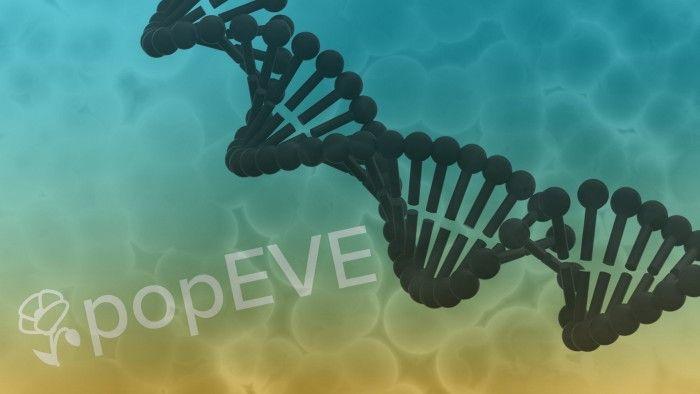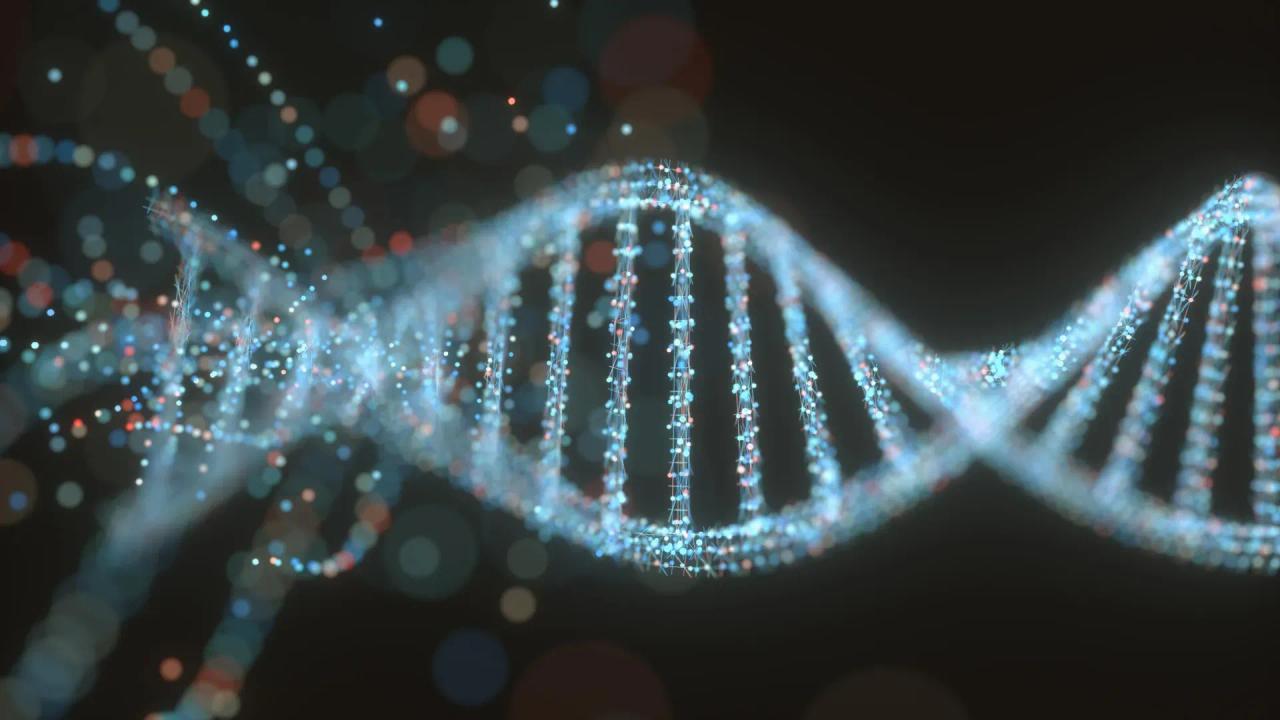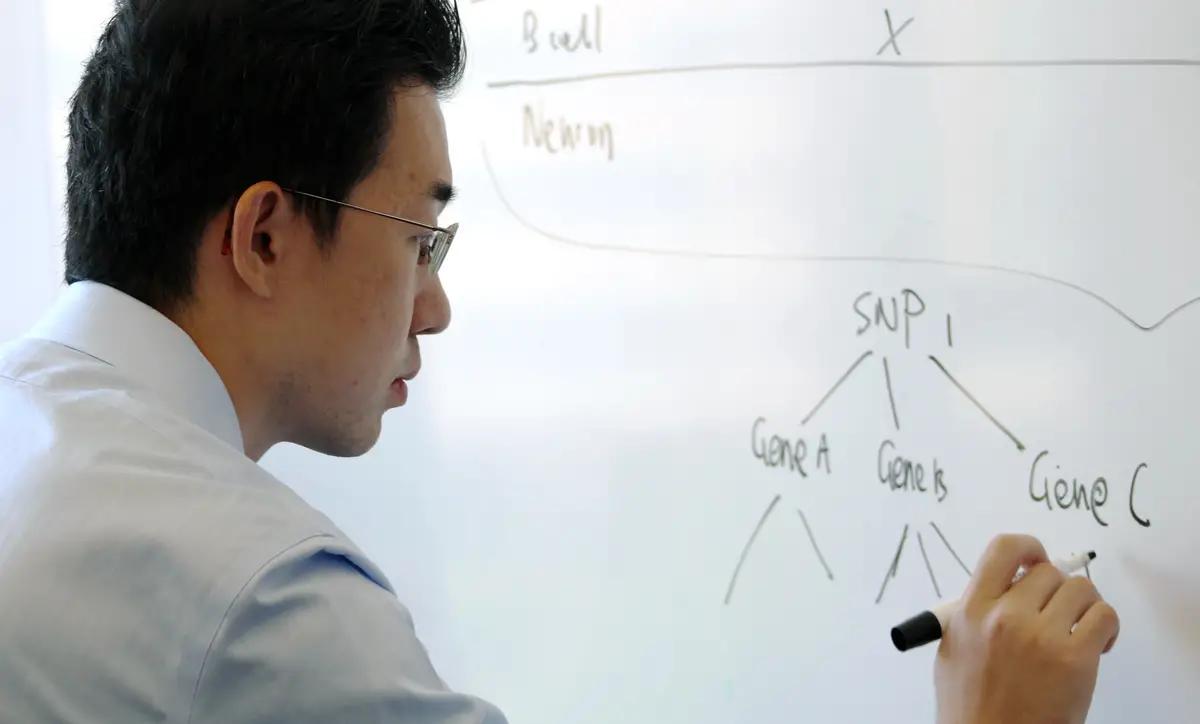New AI Model popEVE Revolutionizes Rare Disease Diagnosis Using Evolutionary Data
2 Sources
2 Sources
[1]
New AI model enhances diagnosis of rare diseases
Scientists have built an artificial intelligence model to flag if previously unknown human genetic mutations are likely to cause disease, potentially transforming possibilities for the treatment of rare conditions. The technique draws on evolutionary information from hundreds of thousands of mainly animal species and outperforms rivals including Google DeepMind's AlphaMissense, the researchers said. The innovation promises to offer doctors extra data to tackle medical problems they have never seen and may even be genetically unique in their origins. Rare diseases are estimated to affect hundreds of millions of people worldwide in aggregate, but many sufferers are never diagnosed. "There's many ways in which single genetic variants can give rise to disease -- and for this very large number of patients there's often a terrible scarcity of information out there," said Jonathan Frazer, a researcher at the Centre for Genomic Regulation in Barcelona. "It's hard to diagnose the disease, it's hard to understand how to treat the disease. We're hoping that we've just provided a new very general tool to help guide this process." The Barcelona-based scientists worked with colleagues from Harvard Medical School to build the AI model, known as popEVE. The technology, which is described in a paper published in Nature Genetics on Monday, draws on a 2021 algorithm called EVE -- standing for Evolutionary model of Variant Effect. The scientists examined how changes in genes affect the instructions they give the body to produce proteins, the building blocks of life. In particular, they focused on "missense" mutations -- changes that result in a switch in the identity of a single amino acid, the basic subunit of proteins. The researchers looked at the evolutionary diversity of genetic sequences in different species to gauge whether possible mutations were likely to be harmful. If genetic changes are absent from the records it may mean they are destructive, since the organisms suffering from them would have had poor survival prospects. The scientists combined these patterns with readings from the UK Biobank and gnomAD human genetic databases. This allowed them to calibrate the data from animals and other organisms with information on what kinds of mutations healthy people can tolerate. The researchers tested the model on genetic data from 31,000 families with children who suffered severe developmental disorders. In 513 cases where the youngsters showed a completely new genetic mutation, popEVE correctly identified it as the most damaging variant in their bodies 98 per cent of the time. The model further revealed 123 genes that are in many cases active in the growing brain and interact physically with known disease-causing proteins, but have never before been linked to developmental disorders. PopEVE worked better than models developed by Google DeepMind and others at predicting the severity of diseases and in catering to populations of non-European ancestries, the researchers said. Google DeepMind did not respond to a request for comment. The popEVE model does not require large amounts of energy to run and so might be well suited to low- and middle-income countries, the researchers suggested. It had already been successfully used on patients in Senegal, including to help treat a muscular atrophy sufferer with a vitamin B2 boost, they added. PopEVE significantly expanded the capabilities of the original EVE and would be particularly helpful for patients for whom parental genetic samples were not available, said Damian Smedley, computational genomics professor at Queen Mary University of London. "This latest work will allow scalable application to every gene," Smedley said. "Being able to systematically assess the impact of all variants in a patient's genome is key to fully delivering the promise of genomic sequencing in healthcare."
[2]
New Artificial Intelligence Model Could Speed Rare Disease Diagnosis | Newswise
Newswise -- Every human has tens of thousands of tiny genetic alterations in their DNA, also known as variants, that affect how cells build proteins. Yet in a given human genome, only a few of these changes are likely to modify proteins in ways that cause disease, which raises a key question: How can scientists find the disease-causing needles in the vast haystack of genetic variants? For years, scientists have been working on genome-wide association studies and artificial intelligence tools to tackle this question. Now, a new AI model developed by Harvard Medical School researchers and colleagues has pushed forward these efforts. The model, called popEVE, produces a score for each variant in a patient's genome indicating its likelihood of causing disease and places variants on a continuous spectrum. In a paper published Nov. 24 in Nature Genetics, the scientists show that popEVE can predict whether variants are benign or pathogenic (disease-causing) and which variants lead to death in childhood versus adulthood. The model was able to identify more than 100 novel alterations responsible for undiagnosed, rare genetic diseases. "Our goal was to develop a model that ranks variants by disease severity -- providing a prioritized, clinically meaningful view of a person's genome," said co-senior author Debora Marks, professor of systems biology in the Blavatnik Institute at HMS. The team hopes that popEVE can help clinicians diagnose single-variant genetic diseases -- especially rare diseases -- more quickly and accurately. The model could also be used to identify new drug targets for genetic conditions. The tool complements efforts across the HMS community to conduct research, build AI tools, and engage in nationwide collaborations to improve the diagnosis and treatment of rare diseases. As genomic sequencing has become more accessible, physicians have had access to an increasing amount of information about their patients' genetic variants. However, for variants whose link to disease remains poorly understood, identifying which of those variants are responsible for a patient's condition tends to be time-consuming, inefficient, and sometimes fruitless. As a result, many patients with rare or unique genetic diseases remain undiagnosed for years. Several years ago, the Marks Lab developed a generative AI model called EVE that uses deep evolutionary information from different species to learn patterns of mutations that are highly conserved in biology. EVE can then make predictions about how variants in human genes affect protein function. But EVE couldn't easily compare variants on different human genes to determine which might be the most problematic for health. The same is true of other variant prediction models that have emerged in recent years, the researchers said. The team believed that finding a better way to compare variants across genes might help clinicians choose which variants to prioritize in their research when trying to diagnose and care for patients, said Rose Orenbuch, a research fellow in the Marks Lab and lead author on the new paper. To create popEVE, the researchers added two components to EVE: a large-language protein model, which learns from the amino acid sequences that make up proteins, and human population data that captures natural genetic variation. In doing so, they were able to calibrate the model so that the score it produces for each variant can be compared across genes. Because popEVE combines cross-species and within-species information, it reveals how much a variant affects protein function as well as the importance of that variant for human physiology, Marks explained. When the researchers tested popEVE on documented variants and case studies, they found that it successfully: Importantly, the model did not show ancestry bias by performing worse in people from underrepresented genetic backgrounds and did not overpredict the prevalence of pathogenic variants. The researchers then applied popEVE to a cohort of around 30,000 patients with severe developmental disorders who had not yet received a diagnosis. "These are diseases that we assumed were genetic and caused by a single variant based on their severity, but the variant hadn't been found," said Orenbuch. The analysis led to a diagnosis in about one-third of cases. Perhaps most notably, the model identified variants on 123 genes linked to developmental disorders that had not been previously identified -- essentially finding the likely genetic causes of the disorders. In fact, 25 of these genes have since been independently confirmed by research in other labs to cause the disorders. Marks and colleagues are now working on making popEVE available to clinicians and researchers to use and validate in the real world. Scientists can access popEVE via an online portal. The team is also collaborating with organizations including the Children's Rare Disease Collaborative at Boston Children's Hospital, the Division of Human Genetics at the Children's Hospital of Philadelphia, and Genomics England in partnership with the Wellcome Sanger Institute. Marks reports that a clinician-researcher at Centro Nacional de Análisis Genómico in Barcelona, Spain, has been using popEVE to interpret variants in his patients -- information that has helped him make several rare-disease diagnoses. "I feel like we are a step closer to popEVE being useful in the day-to-day pipeline of trying to diagnose genetic diseases faster," Orenbuch said. She added that she is especially excited about the model's potential for patients who have been unable to receive a diagnosis through standard methods. "These are the cases where we have to look outside of the known disease genes, and popEVE has already found a lot of gene candidates," she said. The team noted that while popEVE will need to be further verified to ensure its safety and accuracy before it is widely adopted in the clinic, they hope it can eventually increase clinicians' confidence in using computational models for genetic diagnoses. The researchers are also integrating popEVE scores into existing variant and protein databases such as ProtVar and UniProt, which will allow scientists worldwide to use the model to compare variants across genes. By pinpointing the genetic origins of rare or complex diseases, the researchers noted, popEVE may also identify new targets and avenues for drug development. "We think prioritizing variants based on predicted disease severity will improve the odds of diagnosis and ultimately pave the way for better treatment and drug discovery," Marks said. Mafalda Dias and Jonathan Frazer were co-senior authors on the paper. Additional authors include Courtney A. Shearer, Aaron W. Kollasch, Aviv D. Spinner, Thomas Hopf, Lood van Niekerk, and Dinko Franceschi. Funding for the work was provided by a Chan Zuckerberg Initiative Award (Neurodegeneration Challenge Network, CZI2018-191853), a National Institutes of Health Transformational Research Award (TR01CA260415), a National Science Foundation Graduate Research Fellowship, the Spanish Ministry of Science and Innovation (PID2022-140793NA-I00; CEX2020-001049-S; MCIN/AEI/10.13039/501100011033, MCIN/AEI/10.13039/501100011033/FEDER, UE), and the Generalitat de Catalunya (Government of Catalonia) through the CERCA program.
Share
Share
Copy Link
Scientists develop popEVE, an AI model that outperforms Google DeepMind's AlphaMissense in identifying disease-causing genetic mutations. The tool successfully diagnosed rare developmental disorders in thousands of patients and discovered 123 previously unknown disease-linked genes.

Revolutionary AI Model Transforms Rare Disease Diagnosis
Scientists have developed a groundbreaking artificial intelligence model called popEVE that significantly outperforms existing tools, including Google DeepMind's AlphaMissense, in identifying disease-causing genetic mutations. The innovation promises to transform diagnosis and treatment possibilities for rare conditions that affect hundreds of millions of people worldwide
1
.The model, described in a paper published in Nature Genetics, was developed by researchers at the Centre for Genomic Regulation in Barcelona working alongside colleagues from Harvard Medical School. PopEVE builds upon a 2021 algorithm called EVE (Evolutionary model of Variant Effect) and represents a significant advancement in genomic medicine
2
.How popEVE Works
The AI model employs a sophisticated approach that combines evolutionary information from hundreds of thousands of species with human population data. It focuses specifically on "missense" mutations—genetic changes that result in switching the identity of a single amino acid, the basic building blocks of proteins
1
.The researchers examined evolutionary diversity across different species to determine whether genetic mutations were likely harmful. If certain genetic changes are absent from evolutionary records, it suggests they may be destructive since organisms carrying them would have had poor survival prospects. This evolutionary data was then calibrated with information from the UK Biobank and gnomAD human genetic databases to understand what mutations healthy people can tolerate
1
.PopEVE incorporates two key components: a large-language protein model that learns from amino acid sequences, and human population data capturing natural genetic variation. This combination allows the model to produce comparable scores across different genes, addressing a significant limitation of previous tools
2
.Clinical Validation and Performance
The model underwent extensive testing on genetic data from approximately 31,000 families with children suffering from severe developmental disorders. In 513 cases where children showed completely new genetic mutations, popEVE correctly identified the most damaging variant 98 percent of the time
1
.Perhaps most significantly, the analysis led to diagnoses in about one-third of previously undiagnosed cases. The model identified 123 genes linked to developmental disorders that had never before been associated with such conditions. Many of these genes are active in the developing brain and interact physically with known disease-causing proteins. Remarkably, 25 of these newly identified genes have since been independently confirmed by other research laboratories
2
.Related Stories
Global Accessibility and Impact
A crucial advantage of popEVE is its energy efficiency, making it particularly suitable for deployment in low- and middle-income countries where computational resources may be limited. The model has already demonstrated real-world success, including helping treat a muscular atrophy patient in Senegal with a vitamin B2 boost
1
.Importantly, the model showed no ancestry bias, performing equally well across different genetic backgrounds—a significant improvement over some existing tools that may underperform in underrepresented populations .
The researchers are now working to make popEVE available to clinicians and researchers worldwide through an online portal, collaborating with organizations including the Children's Rare Disease Collaborative at Boston Children's Hospital to validate the tool in real-world clinical settings
2
.References
Summarized by
Navi
Related Stories
Recent Highlights
1
Google launches Gemini 3 Flash as default AI model, delivering speed with Pro-grade reasoning
Technology

2
OpenAI launches GPT Image 1.5 as AI image generator war with Google intensifies
Technology

3
OpenAI launches ChatGPT app store, opening doors for third-party developers to build AI-powered apps
Technology








